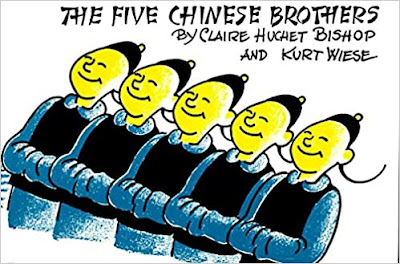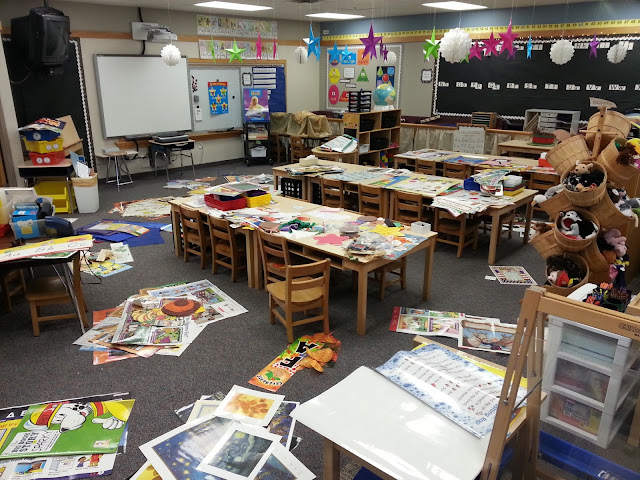March Bulletin Boards and Navigating Seuss
My students began asking me when I was going to update our library bulletin board and displays in late February, which made me happy as their interest confirmed that they were at the very least noticing the passive advertising of reading and books that I hoped would engage them before and after their class visits to the library. I knew I'd be promoting Read Across America and also knew that this would be my first year navigating the racism issues surrounding some of Dr. Seuss' books on a schoolwide scale, rather than just in my kindergarten classroom.
My students come from all over the United States and world, their parents members of the armed forces. They've been born in one location and will travel to and live in many more throughout their childhoods and will likely encounter a broader range of cultures and belief systems than their rural neighbors who live off post. Diverse ethnic backgrounds and languages other than English enrich our school's tapestry. I myself am considered bi-racial, half Inupiaq Eskimo and half Caucasian. Unless I'm wearing a kuspuk or my native artisan jewelry, most people guess that I'm of Hispanic descent.
The passing of my mother a month ago has resulted in the expected self-reflection that I anticipated. Looking back over my childhood, I appreciate having been brought up by an educator who also had the benefit of living the life of a military brat. Diversity didn't frighten my mother, and it was her opinion that we were allowed to cherrypick from all of the good in the world, and leave the rest behind. As happens with adulting (and parenting), the practice of this belief would occasionally result in unanticipated issues, but she never recanted.
Teaching kindergarteners for a quarter of a century, I spent most of my time celebrating reading and providing diverse books to my students. Over the years as the popularity of both mistrusting teachers and scripting curriculum grew, it became even more important to grow my own classroom library to supplement the books and stories that children were denied by the adoption of "robust" curriculum kits that really only provided trade books. My own childhood copies of many Dr. Seuss books sat with Elephant and Piggie, Clifford, and Franklin. Over time, books by Mac Barnett, Oliver Jeffers, and many different retellings of fairy and folk tales along with stacks of non-fiction books were added to my bookshelves, and my collection steadily evolved.
I made decisions both professional and personal when it became obvious that books like this story, well-loved by students, needed an update:
The copy of the yellow-skinned brothers came home, and the version below was shared with students. Slightly different story, the same magic, and no purposely inaccurate and hurtful imagery regarding race.
My library has both copies of the books, and I'm in no rush to weed the version by Claire Bishop simply because older students may want to see examples of how the depiction of once minority groups or cultures other than "White" portrayed and encouraged racist stereotyping. They can explore the reasons behind the need for accurate portrayals of diverse peoples, and they can even decide which oral version of the story itself, read without illustrations, they prefer.
I've made and worn a yellow Star Bellied Sneetch shirt for many Read Across America celebration days, and have taught students how to make Thing 1 and Thing 2 headbands, tracing "Reading is our Thing" across the front. Students over the years have been able to articulate pretty clearly that "it's what inside that counts" and that "treating people differently because they don't look or sound like you is wrong." A couple of kindergarten students even pointed out that there aren't many girls in Dr. Seuss books, "just boys and weird animals." They're right.
Many of my colleagues appear unaware of the issues regarding how Seuss' illustrations have led to the recent calls to cease publication of some of his books and the NEA's decision to reframe and perhaps rebrand Read Across America from a celebration of his birthday and books into an event much more inclusive and diverse. Meanwhile, quite a few colleagues that I know through my social media PLN have been extremely vocal about their opposition to any and all things Seuss. Our SITE Council was given free-reign over this year's guest reader event and, likely due to the popularity of the Seuss brand (you find products easily in most stores every year), the "fun" and "cuteness" appeal of Seuss dress-up days, and frankly the ease of recycled content, Seuss was impossible to avoid. Still, employing my mother's mantra, I cherrypicked. Young readers enjoy Green Eggs and Ham, How the Grinch Stole Christmas, and Horton Hears a Who. Mid and upper-grade students enjoy sharing developing vocabulary to describe lessons embedded within Seuss' stories ("it's not nice" evolves into "it's unfair to exclude others"). Just as I regularly shared with my Super Star kindergarteners, I explained to all students last week that although The Sneetches is my favorite Dr. Seuss story, I understand that he wasn't really a doctor and that he wasn't perfect: some of his stories and drawings upset people for good reason. We have the right to read what we want, and I choose to not read some of his books. I can recognize Seuss without celebrating him, and yes, I will use some of his books to hook readers, just as I choose some, not all books by all authors for the same purpose. And though the NEA suggested a focus on diverse titles, I chose to go my own route to focus specifically on the lives my students experience: I identified books set in different states to help us read across America.
Dr. Seuss characters appear in our glass display case, and book covers and identifying states are spread across our hallway bulletin board. Our March displays and featured books also include a nod to Irish folklore and student-voted interests, dinosaurs and space. Just as I've featured diverse titles throughout the year and not just during the months in which they're usually given the spotlight, I'm hoping that the displays I'm planning for April and May engage readers as much as these.
I'm a week away from Spring Break with some predicted winter weather that will prevent me from spending time in my greenhouse, and I'll be performing my first-ever inventory of the library as the end of the year draws closer. This school year has flown by and has been full of stress and some loss, broken up with sprinklings of joy, positivity, and humor. I hope appropriate and needed school librarianship and my professional purpose continue to align.


















Comments
Post a Comment